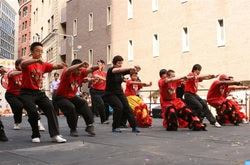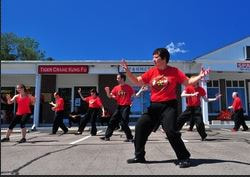
Kung Fu
Hung Gar Kung Fu is a Southern Style Kung Fu (Nam Kuen), which trains both internal as well as external martial arts. Power is generated using a combination of hardness as well as softness through a rich collection of traditional techniques. The techniques, demonstrated in the forms, focus on their effectiveness with graceful and natural movements.
Self-defense and effective fighting techniques are the emphasis of Hung Gar Kung Fu. The Hung Gar practitioner combines internal and external power, while strengthening the body, bones and ligaments.
The foundation of Hung Gar is the 12 Bridge Hands: 1. Gong (Hard); 2. Yao (Soft); 3. Bic (Force); 4. Jik (Straight); 5. Fun (Separate); 6. Deng (Stable); 7. Chuen (Spear); 8. Tai (Lift); 9. Lau (Stream); 10. Wun (Delivery); 11. Jai (Control); 12. Ding (Nail)
The bridge hands contain all the energies and give the practitioner the skills to apply power that is subtle and strong with the ability to change as a technique is applied. Hung Gar fundamentals are based on the constructive and destructive concepts in the Five Element Theory. Hung Gar also includes multiple weapon skills including swords, knives, and short/long weapons.
The Hung Gar practitioner is always defensive, not throwing the first punch. Efficient and effective, the block / bridge also becomes the strike. When used in this manner, the skilled Hung Gar student quickly defeats their aggressor.
Hung Gar Kung Fu is a Southern Style Kung Fu (Nam Kuen), which trains both internal as well as external martial arts. Power is generated using a combination of hardness as well as softness through a rich collection of traditional techniques. The techniques, demonstrated in the forms, focus on their effectiveness with graceful and natural movements.
Self-defense and effective fighting techniques are the emphasis of Hung Gar Kung Fu. The Hung Gar practitioner combines internal and external power, while strengthening the body, bones and ligaments.
The foundation of Hung Gar is the 12 Bridge Hands: 1. Gong (Hard); 2. Yao (Soft); 3. Bic (Force); 4. Jik (Straight); 5. Fun (Separate); 6. Deng (Stable); 7. Chuen (Spear); 8. Tai (Lift); 9. Lau (Stream); 10. Wun (Delivery); 11. Jai (Control); 12. Ding (Nail)
The bridge hands contain all the energies and give the practitioner the skills to apply power that is subtle and strong with the ability to change as a technique is applied. Hung Gar fundamentals are based on the constructive and destructive concepts in the Five Element Theory. Hung Gar also includes multiple weapon skills including swords, knives, and short/long weapons.
The Hung Gar practitioner is always defensive, not throwing the first punch. Efficient and effective, the block / bridge also becomes the strike. When used in this manner, the skilled Hung Gar student quickly defeats their aggressor.

Tai Chi
The essence of Tai Chi practice is the development and use of the body's internal energy, Chi. How Chi transforms, moves through the body, and works as a living force is explained and symbolized by the Yin and Yang theory.
The philosophy of Tai Chi is to naturally promote the health of the body. Tai Chi does this through practicing the Tai Chi form, performing Martial Art techniques, and using authentic Taoist Qigong breathing methods. Mastering proper breathing is essential to directing the Chi to travel around the human body's 12 Chi meridians and the 108 major points. Frequent practice of Tai Chi can promote healthy heart function, improve the respiratory system, enhance blood circulation, and reinforce the body's metabolism. It can also improve one's range of motion, flexibility and balance, helping to minimize falls.
The essence of Tai Chi practice is the development and use of the body's internal energy, Chi. How Chi transforms, moves through the body, and works as a living force is explained and symbolized by the Yin and Yang theory.
The philosophy of Tai Chi is to naturally promote the health of the body. Tai Chi does this through practicing the Tai Chi form, performing Martial Art techniques, and using authentic Taoist Qigong breathing methods. Mastering proper breathing is essential to directing the Chi to travel around the human body's 12 Chi meridians and the 108 major points. Frequent practice of Tai Chi can promote healthy heart function, improve the respiratory system, enhance blood circulation, and reinforce the body's metabolism. It can also improve one's range of motion, flexibility and balance, helping to minimize falls.

Lion Dance
We perform lion dances for various activities such as Lunar New Year, Birthdays, Weddings, Corporate Events...whenever there is a celebration!
Call for pricing and availability!
Lion dance is performed with two individuals under the lion head and body. Lion dance partners demonstrate energetic agile movements combined with strong kung fu stance work to make the lions come alive.
Originating from southern China, our style emphasizes strong stances, firm and energetic actions and acrobatic tricks, which demonstrate the performers' kung fu skills.
The lions are accompanied by the ever-present instruments, drum, cymbals, and gong. The instruments work with the lions to keep them lively and active.
During the Chinese New Year, the dancing lions travel through the streets, bringing joy and prosperity wherever they go. They will visit the storefront of businesses to "Choi Chang" (pick the greens). Businesses usually tie a red envelope filled with money to a head of lettuce and hang the bundle high above the front door. The lion approaches the lettuce like a curious cat, consumes the lettuce with caution and spits out the leaves. Lion dances are also performed on other special occasions such as festivals, weddings and business openings.
We offer a comprehensive lion dance curriculum covering exercises to build strength and stamina, Kung Fu foundations, musical instruments (drum, gong, and cymbals) and the role of the playful Buddha.
We perform lion dances for various activities such as Lunar New Year, Birthdays, Weddings, Corporate Events...whenever there is a celebration!
Call for pricing and availability!
Lion dance is performed with two individuals under the lion head and body. Lion dance partners demonstrate energetic agile movements combined with strong kung fu stance work to make the lions come alive.
Originating from southern China, our style emphasizes strong stances, firm and energetic actions and acrobatic tricks, which demonstrate the performers' kung fu skills.
The lions are accompanied by the ever-present instruments, drum, cymbals, and gong. The instruments work with the lions to keep them lively and active.
During the Chinese New Year, the dancing lions travel through the streets, bringing joy and prosperity wherever they go. They will visit the storefront of businesses to "Choi Chang" (pick the greens). Businesses usually tie a red envelope filled with money to a head of lettuce and hang the bundle high above the front door. The lion approaches the lettuce like a curious cat, consumes the lettuce with caution and spits out the leaves. Lion dances are also performed on other special occasions such as festivals, weddings and business openings.
We offer a comprehensive lion dance curriculum covering exercises to build strength and stamina, Kung Fu foundations, musical instruments (drum, gong, and cymbals) and the role of the playful Buddha.
